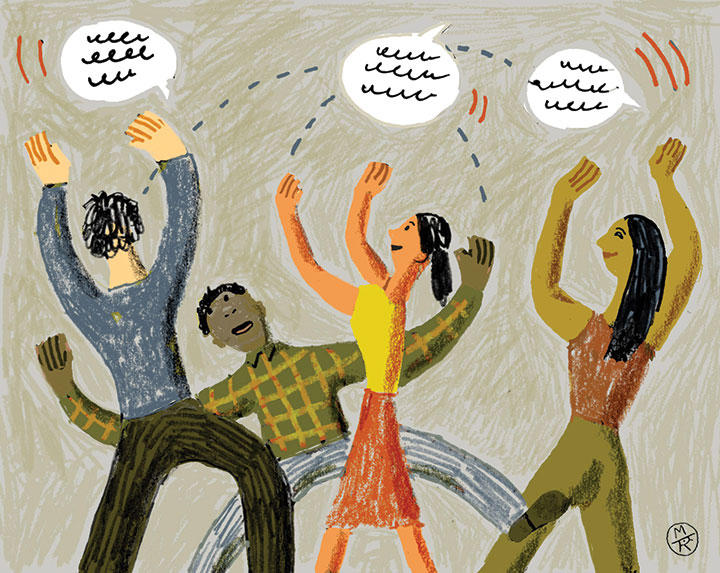‘Were You Funny?’ Improv Lessons Help Grad Students Onstage and Off
It’s 9 p.m. on a Tuesday, and I’m at the DBar pretending to be a dairy cow. If this seems strange for an engineering Ph.D. student, I agree. It might also make me a better collaborator and conversationalist, but I’m getting ahead of myself.
It all started six weeks ago, when I sat down in Green Hall with a dozen other graduate students. The attraction: a beginner improv series led by the Graduate Improv Club. Sara Chuang, a fifth-year Ph.D. student in chemical and biological engineering, was our fearless leader, shepherding us from shy, awkward first-time comedians to a troupe that by the end was anything but shy, if still a little awkward at times.

We started slowly. The first workshop was about loosening up. We played word-association games, mirrored each other’s movements, and learned the cardinal rule of improv: Always say, “Yes, and ... ”
“Sometimes the other person has a picture or an idea for the scene,” explained Holden Lee, a fourth-year Ph.D. student in math. “How do I support that while still adding to it?”
Over the weeks, we added more complex games. Some emphasized physicality, like “Puppets,” where people performed with their limbs controlled by “puppeteers” behind them. Others were about letting imaginations run wild, like “Lunch Line,” where a normal rumor got crazy as it spread along a cafeteria line.
At the end of each session, we talked about what we wanted to improve — a challenge when we knew we’d never do those particular scenes again. As Levent Aygun, a fifth-year Ph.D. student in electrical engineering, recalled: “I do a scene, and for the next week I think about what I should’ve said instead.”
By now, you may be wondering the same thing my roommate was whenever I got home: “So ... were you funny?” My answer is a hesitant, “I think so.”
The truth is we didn’t learn to be funny. We learned to be good scene partners, to say the first thing that came to mind, to convey context without being too direct. We also spent time honing our animal impressions, which probably did look funny to anyone who passed the room of grad students stomping around making elephant noises.
But in five weeks, the one thing we learned about how to be funny was to do nothing at all — because, according to Chuang, “You are all inherently funny!” And if there’s one thing I was most surprised by, it’s that she was right.
What made our scenes funny was individuality — any two people hearing the same line inevitably responded differently. In a game called “Movie Genres,” my prompt was “sidewalk,” and the style was “documentary.” I swooped in like the Discovery Channel, pretending to narrate a nature video of “a human child playing hopscotch.” I thought this was funny, but it didn’t get laughs until my partner whipped around and snapped, “Mom! I told you to stop filming me!”
In many ways, what’s funny about improv is that saying the first thing that comes to mind reveals how differently our minds work. This is particularly true with students whose academic passions span everything from Russian literature to photovoltaics. Embracing these differences can help us interact offstage as well.
“What actually got me hooked in the email was, ‘Are you tired of small talk?’” said Elizaveta Mankovskaia, a fourth-year Ph.D. student in Slavic languages and literatures. “Improv is creative and theatrical, but it’s also very applicable in regular life.”
So back to the DBar, at the performance that culminated our series. The audience loves my talking cow, and it’s bittersweet knowing I won’t use it again. But I’m proudest of how I’m blending with the once-strangers in my scene and responding to cues I’ve never heard before. That I will do again — in academic and personal life — and much like improv, it’ll be different every time.












No responses yet